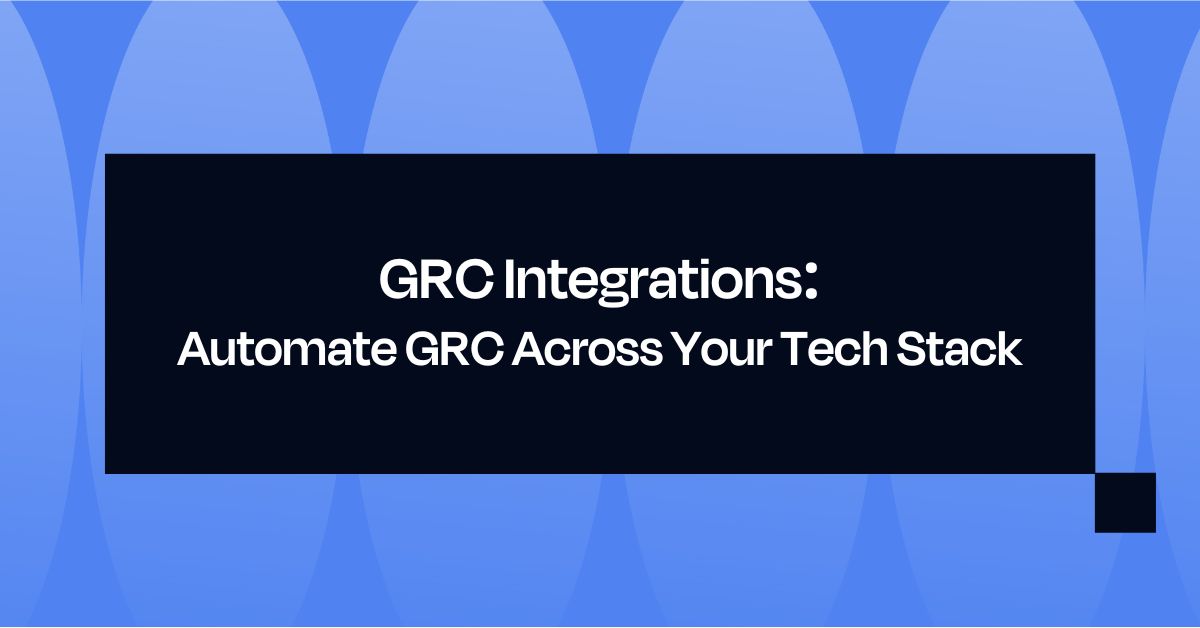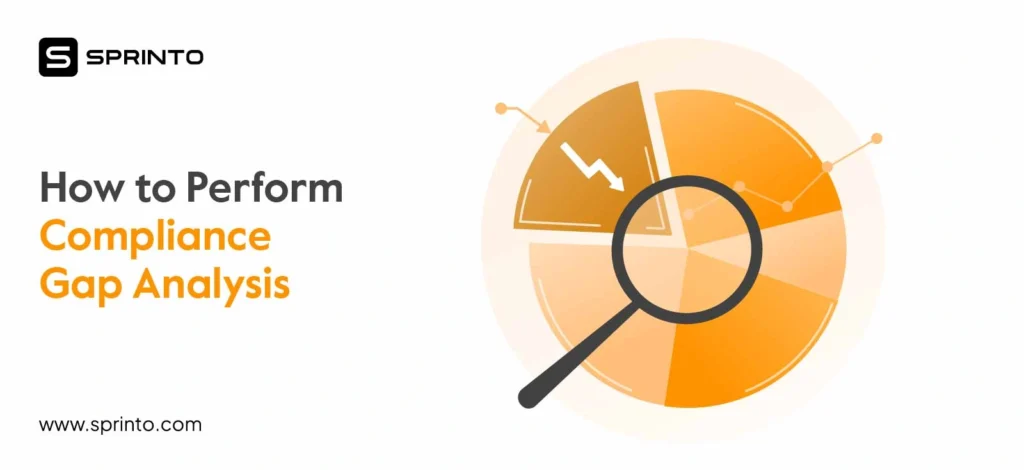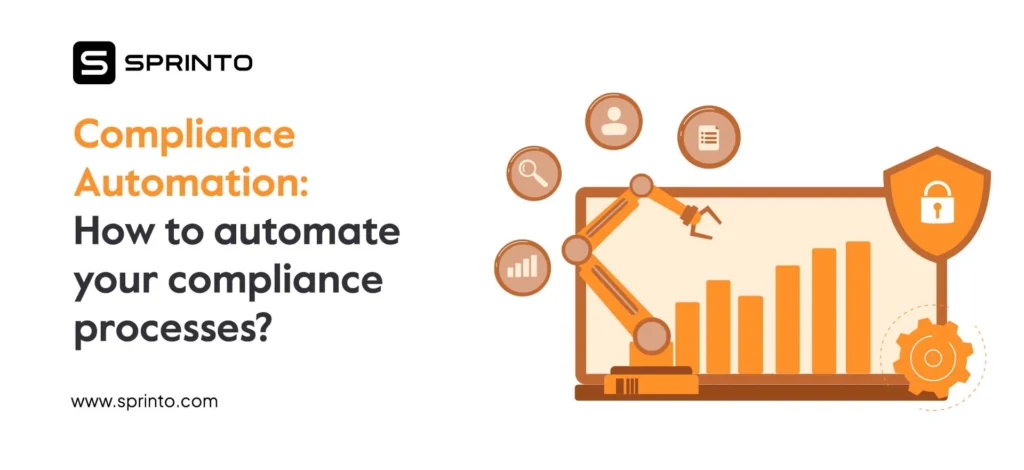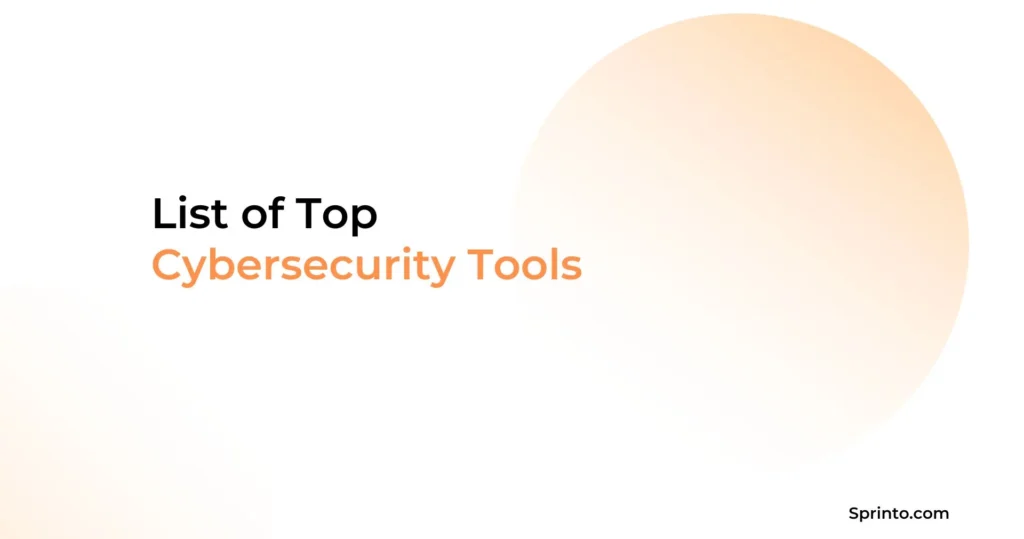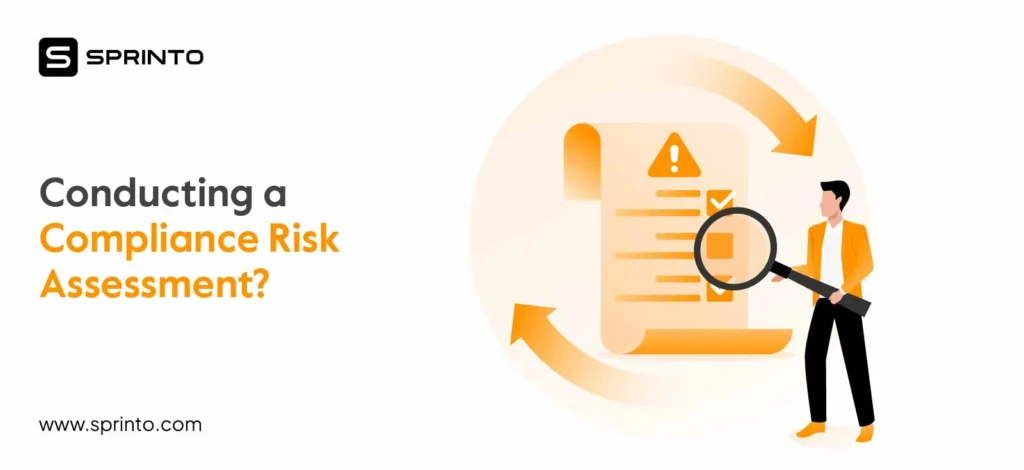GRC integrations are crucial to better managing risk. Let’s look at it this way: What percentage of your audit prep time is spent proving things you already know are true versus discovering things that might be false?
If you’re like most companies, it’s 90% proving and 10% discovering. You know MFA is enforced. You know access is reviewed quarterly. You just need to demonstrate it. This requires you to collect evidence from systems that contain that evidence manually. However, this is not ideal. The ROI of compliance should be risk reduction.
But when your GRC platform is disconnected from your actual systems, you spend all your time on documentation and none on the questions that matter: Are the controls working? Where are the gaps? Are we fixing them faster than we did last quarter?
GRC integrations flip this ratio. When evidence collection is automated, you free up time for genuine risk management endeavors.
What are GRC integrations?
A GRC integration connects various systems across your tech stack (cloud infra, HR systems, ticketing systems, etc.) to build a unified, automated approach to governance, risk, and compliance (GRC). Compliance is only as substantial as the systems it connects.
Through these GRC software integrations, organizations can automatically collect audit evidence, align IT operations with business objectives, unify risk and control data, and maintain real-time visibility into their compliance posture.
In simple terms, governance, risk, and compliance integrations help your compliance software “talk” to the rest of your business systems, creating a continuous feedback loop between operations and oversight.
For example, when your Okta instance provides a new user, your GRC ticket marks a security control as “remediated,” that status updates in real time. When someone changes a critical cloud configuration, you get alerted before it becomes an audit finding.
This is what we call connected compliance. You always have a single, trustworthy source of truth across your tech stack.
Why GRC integrations matter?
GRC integrations give organizations real-time visibility into their security and compliance posture. Disconnected tools create disconnected stories. If your risk data lives across AWS, Jira, Slack, and spreadsheets, there’s no unified view of what’s happening right now.
And, the stakes keep on rising. You’re managing more frameworks (SOC 2, ISO 27001, and HIPAA), cloud environments, remote employees, and vendors. Evidence volume grows substantially while your team size doesn’t.
Without GRC platform integrations, you’re dealing with:
Disconnected risk data across departments
Without integrations, each department maintains its own view of compliance. Security leadership sees one version of risk posture, and compliance sees another. You discover these misalignments during audit prep, leading to audit fire drills.
Picture this: Your security team ran a vulnerability scan showing 23 critical findings remediated in Q1. Your compliance spreadsheet shows 18. Your Jira board shows 21 closed tickets. Which number goes in the audit report? Nobody is sure.
Manual evidence gathering creates compliance gaps
Manual snapshots can’t prove continuous compliance. They prove you were compliant on the days you remembered taking screenshots.
Additionally, some is already outdated when you manually collect evidence from ten different systems. Manual snapshots prove compliance at a point in time, but cannot provide a real-time view into compliance.
Inconsistent audit trails
Different people document differently. One team member exports logs with full timestamps, while another takes screenshots, and a third writes summary descriptions.
Auditors who review your evidence see a patchwork mess that doesn’t inspire confidence.
Zero real-time risk visibility
You’re managing risk through the rearview mirror. That critical vulnerability that appeared last week? You won’t know about it until the next manual scan cycle. You’re reactive by default because your systems don’t talk to each other.
Your vulnerability scanner detected CVE-2024-1234 with a CVSS score of 9.8 on January 15th. That vulnerability might be unacknowledged for days or weeks until the following manual review.
These were precisely the challenges faced by WebEngage, a fast-growing customer-engagement platform. Their security team needed a compliance solution that could keep up with cloud-native change and avoid the drag of manual evidence tracking. By adopting Sprinto’s integrations-rich, automation-enabled compliance platform, WebEngage leveraged native connectors to Google Workspace, GitLab, and Jira to centralize infrastructure, access, and incident/vulnerability workflows.
The result: WebEngage became ISO 27001 & ISO 27701 certified in just 6 months. They have also operated four frameworks continuously on the Sprinto platform and have had no major cybersecurity incident in the last 6 years.
Common types of GRC integrations
The best integrating GRC tools connect to systems where compliance events already happen. You’re tapping into existing workflows to create audit-ready evidence automatically.
| Category | What this integration enables | Business impact |
| Cloud infrastructure | Continuous visibility across cloud assets | Reduces audit prep time by auto-mapping evidence to compliance frameworks |
| Identity & access management | Real-time synchronization of user access | Prevents access creep |
| Project management & ticketing | Automated creation and tracking of remediation tasks | Closes the loop on risk faster |
| Communication tools | Real-time alerts & updates delivered directly to team channels | Improves cross-team coordination |
| Vulnerability & security tools | Direct ingestion of vulnerability and threat data | Enables prioritized, evidence-linked risk remediation |
| HR systems | Automated onboarding/offboarding workflows | Eliminates human error during transitions |
| Asset & configuration management | Continuous asset discovery and validation | Maintains an always-accurate inventory |
Here are the seven most common categories of integrations that should come together to build that connected ecosystem:
1. Cloud infrastructure: AWS, GCP, Azure, etc.
Most of your security controls (data encryption, backups, access policies, and configuration baselines) live in your cloud. That’s why cloud compliance monitoring is at the heart of any integration strategy. With GRC integrations, your platform continuously validates the posture of every resource.
The depth of integration matters. Surface-level connections pull resource names or metadata. Deep integrations (like those enabled through Sprinto) go further: they fetch encryption settings, IAM role bindings, backup schedules, and even compliance states from services like AWS Config or GCP Security Command Center. These details are automatically and continuously mapped to relevant controls in frameworks such as SOC 2, ISO 27001, or HIPAA, so every alert ties back to a specific compliance requirement.
2. Identity & access management: Okta, Azure AD, JumpCloud, etc.
Every user provisioned, permission granted, or access revoked is a compliance event waiting to be tracked. When auditors ask about access controls, you show real-time data from your IDP. Modern GRC integrations bring identity data and compliance logic together.
Quarterly access reviews satisfy the checkboxes, but they don’t catch access creep for companies with high turnover or contractors.
Example: A contractor finishes a two-week project but retains database admin rights for six weeks until the following review. An integrated system flags this instantly: “User john.smith@contractor.com: last login 14 days ago, access to production DB, project end date passed.”
Sprinto takes access management even further. It supports adaptive access policies built on contextual factors such as user role, system sensitivity, and project duration. When roles change or access risks increase, Sprinto sends real-time alerts and automatically records those actions as audit evidence.
3. Project management & ticketing: Jira, Asana, Trello, etc.
When you have GRC integrations with ticketing tools in place, every remediation ticket tells the story of a risk identified, acted on, and resolved, and integrations ensure the story is complete.
When your security team creates a Jira ticket to remediate a finding, that ticket becomes evidence. Track remediation automatically and prove that vulnerabilities get fixed.
The result is a shift from reactive firefighting to proactive assurance. Instead of proving that vulnerabilities were logged, you can prove they were resolved on time and verified by control owners.
4. Communication tools: Slack, Microsoft Teams, etc.
Slack or Teams integrations turn compliance into a living conversation. Instead of waiting for email updates or quarterly syncs, with GRC integrations in place, teams receive real-time alerts: failed controls, pending evidence, upcoming access reviews, or risk remediation deadlines.
Alerts route directly to the right owner, so security isn’t buried in inboxes. A failed AWS encryption check? A notification pings your DevOps channel with context, remediation steps, and linked evidence.
5. Vulnerability & security tools: Qualys, Tenable, Rapid7, etc.
GRC API integrations pull vulnerability data automatically. If a high-severity vulnerability is detected, it becomes a tracked risk with ownership and timeline instantly.
A GRC API integration will automatically transfer vulnerability data into risk registers rather than manually transferring CVE data. If a high-severity vulnerability is detected, it instantly becomes a tracked risk with ownership and a timeline.
The risk here is integration without context. Smart GRC integrations don’t just import vulnerabilities; they correlate them. They map each CVE to affected assets in your cloud environment, deployment data from your CI/CD pipeline, and existing control status. That context helps teams prioritize which issues threaten compliance posture versus those already mitigated by existing controls. Consequently, you end up with fewer false alarms, faster remediation cycles, and audit-ready evidence showing what happened and how you responded.
6. HR systems: BambooHR, Rippling, Workday, etc.
Offboarding is where many companies expose themselves to risk.
For example, An employee gives two weeks’ notice on Monday. Their last working day is Friday. IT needs to revoke: AWS access, Okta account, GitHub repos, Slack workspace, VPN credentials, database permissions, API keys, SSH keys, and any shared credential vaults. Manual coordination across IT, security, and department managers means there’s a chance that something gets missed.
While integrated systems create a choreographed workflow: HR marks employee as “terminating on [date]” → GRC platform generates checklist → IT receives specific revocation tasks → Each system confirms access removal → Audit trail captures complete evidence automatically.
Zero missed access revocations.
7. Asset & configuration management: ServiceNow, Intune, etc.
Knowing what assets you have and how they’re configured is the foundation of any compliance posture.
Integrations with device and asset management tools give your GRC platform live visibility into IT assets, configurations, and software states. When a new endpoint is added or a device drifts from its approved baseline, you get immediate detection and automatic logging.
Benefits of GRC integrations
When your systems talk to each other, compliance starts talking business.
Streamlined audit readiness
Your audit prep should be a verification exercise. GRC integrations and audit automation tools ensure evidence is collected automatically through compliance software integrations, organized, timestamped, and mapped to relevant controls. Instead of exporting logs and chasing screenshots, you validate already existing data.
Continuous compliance monitoring
Frameworks like the NIST CSF require continuous evidence of control effectiveness.
With GRC software integrations, your platform monitors controls in real time.
Ongoing checks ensure there is no drift between policies and reality. A misconfigured S3 bucket or an inactive user account is flagged the moment it occurs.
Data accuracy and risk visibility
Automated synchronization eliminates stale data and creates a high-integrity data layer, enabling risk data automation across frameworks like SOC 2 and ISO 27001. GRC integrations help you spot anomalies or recurring failures before they become audit findings
Collaboration across teams
Security, IT, and compliance teams often chase the same data in different formats. GRC integrations create shared visibility. Everyone works from the same shared source of truth rather than parallel versions of it.
Time and cost savings
Middle-market teams often don’t have compliance headcount to spare. Integrations automate manual overhead, allowing your specialists to focus on exceptions.
Best practices for GRC integrations
Integrations deliver real value only when built into your compliance architecture. Here are the five GRC integration best practices:
1. Identify key systems and prioritize automation
Start with your evidence map. Identify where your compliance-relevant data lives. Which systems generate the most evidence or touch the frameworks you care about most? If you’re spending two days every quarter exporting AWS logs, that’s a high-value integration. If you’re manually tracking employee onboarding completion, connecting your HRIS is an instant win.
Start with integrations, eliminating manual tasks like evidence uploads or control mapping.
2. Choose API-first, flexible GRC tools
Flexibility matters more than most people realize. Your stack will change, and an API-first architecture ensures your compliance platform adapts alongside it.
Robust GRC API integration makes your compliance program future-proof. The next time you adopt a new security or analytics tool, it can plug right in without breaking the chain. Future frameworks (like ISO 42001 or AI governance) should slot into the same integrated foundation.
3. Test before you trust
Integrations can silently fail. Run micro-audits or “evidence drills” to confirm real data is flowing.
For example, request proof of encryption from AWS via your GRC platform. If the logs don’t include key details (timestamps, region, config), your integration needs to be tightened. Testing maintains confidence and audit readiness.
4. Review access permissions
Your GRC platform often requires read access to multiple critical systems. Treat integration credentials as privileged accounts: apply least privilege, rotate keys regularly, and monitor usage. Audit these access rights as you would any privileged account.
5. Treat integrations as living systems
Integrations aren’t a one-time project; they evolve with your organization. Review their performance quarterly, add new data sources as frameworks expand, and retire those that no longer provide value. A well-integrated GRC system should adapt as quickly as your tech stack does.
How Sprinto simplifies GRC integrations
Sprinto was built around one idea: compliance should be effortless and enable improved risk posture. Sprinto connects your cloud, identity, HR, and workflow tools into a single, automated layer of governance. Once integrated, it quietly runs in the background, viewing only system configurations and collecting evidence, monitoring controls, and surfacing real-time risks.
Pre-built integrations include:
- Cloud: AWS, GCP, Azure for infrastructure monitoring and configuration compliance
- Identity: Okta, Google Workspace, Azure AD for access management and user lifecycle tracking
- Ticketing: Jira, Slack for remediation tracking and real-time collaboration
- HR: BambooHR, Rippling for onboarding, training, and offboarding verification
With Sprinto, you don’t need scripts or developer time. A wide variety of native integrations allow you to authenticate, choose what data flows, and map it to your controls, for real-time compliance monitoring and insights. For systems without native integrations, Sprinto offers secure APIs, and our team can build new integrations for you post-deal-closure.
Once connected, Sprinto maintains real-time dashboards with continuous compliance integrations. SOC 2 automation means access logs from Okta, infrastructure changes from AWS, and training completions from your LMS all flow automatically, tagged to appropriate SOC 2 controls without manual intervention. AI features automatically spot evidence gaps and help you keep your compliance posture continuously up to date.
Key outcomes from an integrated GRC platform
Let’s talk numbers, because the impact is quantifiable.
- 70% reduction in audit prep time through continuous evidence collection
- Instant validation of controls across cloud and identity
- Unified risk visibility across systems, frameworks, and vendors
- Scalable framework adoption: from SOC 2 → ISO 27001 → HIPAA → GDPR compliance without major or systemic rework
Conclusion
Integration is the foundation of modern compliance. When your systems connect, compliance becomes continuous. When compliance becomes continuous, trust scales automatically. That’s what Sprinto helps you achieve.
Sprinto connects your existing tech stack (AWS, Okta, Jira, BambooHR, and 50+ other tools) into a unified compliance system. Let Sprinto automate the evidence, sync your data, and keep your risk posture audit-ready, all year round. Book a demo to see how it works.
FAQs
1. What are GRC integrations and why are they important?
GRC integrations connect your business systems such as AWS, Okta, Jira, and BambooHR so governance, risk, and compliance data flows automatically between them. Without these connections, compliance data stays in silos, creating delays and manual effort. With integrations in place, evidence collection, control monitoring, and risk tracking become continuous and audit-ready.
2. How do GRC software integrations improve audit readiness?
Audit automation tools that rely on GRC integrations continuously pull configuration, access, and activity data from your systems. This replaces screenshots and spreadsheets with verified, time-stamped evidence mapped to frameworks like SOC 2, ISO 27001, and HIPAA. The result is faster audits, and clear visibility into control effectiveness.
3. What types of systems should a GRC platform integrate with?
An effective GRC platform should integrate with cloud infrastructure (AWS, GCP, Azure), identity and access management tools (Okta, Azure AD), HR systems (Workday, Rippling), ticketing tools (Jira, Asana), and vulnerability scanners (Qualys, Tenable). These integrations ensure complete visibility across your environment, from user onboarding to incident remediation.
4. How do GRC integrations support continuous compliance?
Through GRC API integration and cloud compliance monitoring, your platform validates controls in real time. For example, a misconfigured S3 bucket or overdue access review is flagged immediately. Continuous monitoring closes the gap between policy and practice, helping you maintain ISO 27001 continuous compliance, PCI DSS integration, and GDPR compliance systems without manual intervention.
5. How does Sprinto simplify GRC integrations?
Sprinto offers pre-built connectors and secure APIs for more than 100 tools including AWS, Okta, Jira, and Slack. Once authenticated, Sprinto automatically maps incoming data to relevant controls, runs continuous checks, and highlights gaps. No scripts or developer overhead are required. You get real-time visibility and automated compliance across your tech stack.
Srikar Sai
As a Senior Content Marketer at Sprinto, Srikar Sai turns cybersecurity chaos into clarity. He cuts through the jargon to help people grasp why security matters and how to act on it, making the complex accessible and the overwhelming actionable. He thrives where tech meets business.
Explore more
research & insights curated to help you earn a seat at the table.



